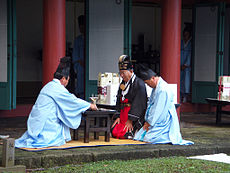- Korean Confucianism
-
Korean Confucianism is the form of Confucianism developed in Korea. One of the most substantial influences in Korean intellectual history was the introduction of Confucian thought as part of the cultural influence from China. Today the legacy of Confucianism remains a fundamental part of Korean society, shaping the moral system, the way of life, social relations between old and young, high culture, and is the basis for much of the legal system. Confucianism in Korea is sometimes considered a pragmatic way of holding a nation together without the civil wars and internal dissent that was inherited from the Goryeo dynasty, and before.
Contents
Goryeo Dynasty Confucianism
King Gwangjong created the national civil service examinations, and King Seongjong was a key figure in establishing Confucianism. King Seongjong established Gukjagam. Gukjagam was the highest educational institution of the Goryeo dynasty. This was facilitated by the establishment, in 1398, of the Sunggyungwan – an academy with a Confucian curriculum – and the building of an altar at the palace, where the king would worship his ancestors.
Neo-Confucianism in the Joseon dynasty
Under Joseon Neo-Confucianism, or seongnihak, there was even greater encouragement of Confucian ideas and ideals such as chung or loyalty; hyo or filial piety; in or benevolence; and sin or trust.
During the Joseon Dynasty, from 1392 on, Confucianism was the primary system of belief amongst the scholarly yangban classes and generals. Koreans historically have found religions natural and easy, and have maintained an overlap between all religions – the Yi family generals, thus restrained Buddhism, maintained shamanism in rural areas, but encouraged Confucianism for its use in administration and social regulation; as well as integrating a civilised society very quickly on Chinese bureaucratic models to increase cultural transference from China.
Korean Confucian schools were built, all of which had foreign educated scholars, large libraries, patronage of artisans and artists, and a curriculum based on Confucian ideals. Thus by the time of King Sejong (ruled 1418–1450), all branches of learning were rooted in this way of thinking although branches of Buddhism in Korea were still let to grow outside of the major political centres in a tolerance of other kinds of worship. The Korean Confucian curriculum of 13 to 15 major works, and exegetical commentary was extensive.
Confucianism in Joseon Korea flourished most notably in the 16th century. Jo Gwang-jo's efforts to promulgate neo-Confucianism among the populace were followed by appearance of Korea's two most prominent Confucian scholars. Yi Hwang (1501–1570) and Yi I (1536–1584), who are often referred to by their pen names Toe gye and Yul gok, are commemorated today on South Korea's 1,000- and 5,000-Won notes respectively, and in the names of major thoroughfares in central Seoul.
As the Joseon dynasty lasted more than five centuries, a rough division of the progression of Korean confucianism is this:
- First century: Governmental administration confucianised
- Second century: Golden age of Confucian philosophers
- Third century: Development of patrilineal lineage system based on power wielded by the eldest son
- Fourth century: Confucian mysticism and seeking of sage-like qualities in ruling classes
- Fifth century: Confucian system breaks down when faced with western encounters, collapse of Qing Dynasty, and Japanese invasions; Confucianism goes underground, to await a revival in the sixth century republican period.
Beginning in the late 17th century, some Confucians began to react to the metaphysical nature of Neo-Confucianism. These scholars advocated more practical social reforms, in a movement known as Silhak.
Contemporary society and Confucianism
Today, the landscape of Confucian schools, temples, places of ancestral worship, and scholarship have been minimized, if not put to the side as historical artifacts worthy only of tourists, scholars, or neglected preservation. However, Confucian values arguably still have an immense influence on the psyche of the Korean people. Moreover, Confucianism is not necessarily regarded as a religion, allowing one to be a Taoist, Christian, or Buddhist and still profess Confucian beliefs.
Strong elements of Confucian thought still exist in day-to-day administrative and organizational hierarchies, but the fixtures and services which brought these into being have disappeared. With Confucianism taken out of the school curricula and removed from the daily life of Koreans, the sense that something essential to Korean history is missing led to a rebirth of Confucianism in the late 1990s. Foreign scholars have also developed an interest in Korean Confucianism as an overriding element of governance that maintained a newly-arisen elite within Korea dependent on all the cohesive devices of Confucianism from the 14th century onwards.
Culturally, the arts still maintain major traditions: Korean pottery, the Korean tea ceremony, Korean gardens, and Korean flower arrangement follow Confucian principles and a Confucian aesthetic. Scholarly calligraphy and the most serious poetry again continue, in much fewer numbers, this heritage. In films, school stories of manners and comic situations within educational frames fit well into the satires on Confucianism from earlier writings. Loyalty to school and devotion to teachers is still an important genre in popular comedies.
Korean Confucian art
See also: Korean art and Korean potteryKorean Confucian art and philosophy had great and deep effects on the Korean culture.
Confucian ceremonies
The most important ceremonies of Korean Confucianism were those that celebrated the coming of age, marriage, death, as well as the anniversary of the death of the ancestors. Funerals had the greatest impact on the lives of ordinary people. Although Confucianism is no longer the ruling ideology, its influence on the contemporary Korean society is not difficult to spot.[citation needed]
The future of Korean Confucianism
Contemporary Confucianists are attempting to bring back a Confucian based college or university that will educate a new generation of scholars. In many cases older temples are being restored by cities for tourist purposes.[citation needed]
See also
- Article 809 of the Korean Civil Code
- Korean Buddhism
- Korean culture
- Korean Taoism
- List of Korea-related topics
- Munmyo
- Religion in Korea
- Silhak
External links
Categories:
Wikimedia Foundation. 2010.

